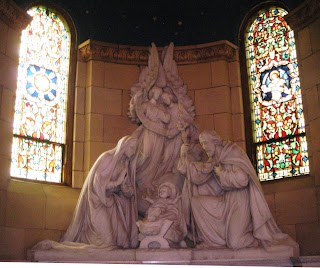 Here in our Redemptoristine monastery we follow an age old custom of contemplative nuns. We eat our main meal on ordinary days without benefit of conversation. Ordinary days are distinguished from feasts or solemnities of the Church calendar or, as is our tradition, the feast days of American or Redemptorist saints. Through the gift of modern technology we no longer have to ask one sister to postpone her meal and read aloud. These days we are listening to audio tapes of talks given by the reknowned scripture scholar Raymond Brown. How wonderful that even after his death we have so many of his lectures to enjoy over and over again. The current series concerns the Infancy Narratives of the Synoptic Gospels. Father Brown makes these stories come alive in new ways by explaning their connection with Jewish tradition and Scripture as well as placing them within the historical and cultural context of the time in which they were written. Such information only serves to expand the theological meaning and teaching which the Gospel writers intended to transmit.
Here in our Redemptoristine monastery we follow an age old custom of contemplative nuns. We eat our main meal on ordinary days without benefit of conversation. Ordinary days are distinguished from feasts or solemnities of the Church calendar or, as is our tradition, the feast days of American or Redemptorist saints. Through the gift of modern technology we no longer have to ask one sister to postpone her meal and read aloud. These days we are listening to audio tapes of talks given by the reknowned scripture scholar Raymond Brown. How wonderful that even after his death we have so many of his lectures to enjoy over and over again. The current series concerns the Infancy Narratives of the Synoptic Gospels. Father Brown makes these stories come alive in new ways by explaning their connection with Jewish tradition and Scripture as well as placing them within the historical and cultural context of the time in which they were written. Such information only serves to expand the theological meaning and teaching which the Gospel writers intended to transmit. A new book published this season for the holiday market is The First Christmas: What the Gospels Really Teach About Jesus's Birth, by two of today's most well known Jesus scholars, Marcus J. Borg and John Dominic Crossan, who joined forces to "show how history has biased our reading of the nativity story as it appears in the gospels of Matthew and Luke." The book jacket continues, "they explore the beginning of the life of Christ, peeling away the sentimentalism that has built up over the last two thousand years around this most well known of all stories to reveal the truth of what the gospels actually say." Marcus J. Borg is Hundere Distinguished Professor of Religion and Culture at Oregon State University. John Dominic Crossan, professor emeritus at De Paul University, is regarded by some as the foremost historical Jesus scholar of our time.
A brief radio interview of these two men drew a great contrast between their approach and that of the esteemed Raymond Brown. In short, they spoke of the stories of Jesus birth as parables, as teaching instruments used much in the same way that Jesus used parables to convey the meaning of his revolutionary concepts. They spoke of the Gospels as pointing to the "primordial sin of empire" which is the human tendency toward control and domination. I could not argue with them there. Further they spoke of the Gospels as not only focusing a spotlight on the sins of the empires of Jesus's time but also of their power reveal in bold print the primordial sin of our empires, most specifically the imperial behavior of the United States in the current world scene. I do not argue with them on this point either. But I do argue that on one hand they did not go far enough with their metaphor and on the other hand left something completely out of the picture.
No comments:
Post a Comment